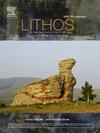东喜马拉雅洛阳地区电气石硼交代作用及流体演化
IF 2.9
2区 地球科学
Q2 GEOCHEMISTRY & GEOPHYSICS
引用次数: 0
摘要
富硼流体与变质岩的相互作用以及诱发电气石化作用在变质和岩浆-热液过程中被广泛观察到。这种相互作用可能对矿床的形成和地壳岩石的物性产生重大影响。然而,硼交代过程中的化学交换和元素转化尚不清楚。本文对东喜马拉雅洛张地区富电气石脉及其寄主岩中的电气石等矿物进行了详细的结构和地球化学研究。在富电气石脉中可识别出两个不同矿物组合带:核心的Pl-Qtz带和边缘的turr - ms带。岩石学证据表明,富电气石脉是由寄主岩(即黑云母片岩)与富b流体反应形成的。电气石颗粒具有明显的分带性,岩心、地幔和岩缘具有明显的主微量元素和硼同位素组成。电气石的核心(turc)具有最高的Mg/(Mg + Fe)比和Sc、V、Cr浓度,以及最低的Ca、Ti、Mn、Li、Be和Zn浓度。电气石(turm)地幔在颜色和组成上均呈现出由turc向turc的连续过渡,这可能是交代系统由围岩控制向流体控制演化的结果。turi - m中Li、Zn和Mn的高浓度表明,所涉及的流体(第一期流体)可能是岩浆流体。tourmaline的边缘(turr - r)在结构和成分上都是均匀的,通常具有中等的Mg/(Mg + Fe)比率和Ca、Ti、Li、Sc、V和Zn浓度,以及相对于turc和turr - m最低的Sc、Cr、Sn和Ba浓度。turi - m和turi - r在边界处的明显成分对比表明注入了外部变质流体(第二级流体)。石英中钛的测温结果表明,流体-岩石相互作用温度从形成turc时的700℃降低到形成turr时的500℃。根据上述温度下的流体-电气石微量元素分配系数和测得的电气石组成,重建了第一期岩浆流体和第二期变质流体的组成。第一期岩浆流体中极高的Li浓度(最高可达1700 ppm)反映了洛张浅花岗岩浆中Li的富集,这与洛张地区含锂辉石伟晶岩的赋存一致。第二阶段变质流体(高达1000 ppm)和围岩黑云母(约2000 ppm)中Li含量较高,表明富黑云母变质岩在流体-岩石相互作用过程中为流体提供了丰富的Li。电气石的硼同位素组成也呈现出系统的变化,δ11B值从turc(−7 ~−9‰)到turm(−9 ~−10‰)逐渐降低。而turr - r的δ11B值有轻微的反弹(−8 ~−9‰)。定量模拟表明,降温和液岩比的变化可以解释从turc到turm再到turr的δ11B值交替上升和下降。研究表明,变质沉积岩中的黑云母是喜马拉雅地区潜在的锂储集层,富硼流体可以有效地从黑云母中提取锂。本文章由计算机程序翻译,如有差异,请以英文原文为准。
Boron-metasomatism and fluid evolution revealed by the chemical and boron isotopic compositions of tourmalines from the Lhozhag area, Eastern Himalaya
The interaction between boron-rich (B-rich) fluid and metamorphic rocks, along with the induced tourmalinization, has been widely observed in metamorphic and magmatic-hydrothermal processes. This interaction may significantly influence the formation of ore deposits and petrophysical properties of crustal rocks. However, chemical exchange and element transformation during the boron-metasomatism process are still not clear. In this study, we present a detailed textural and geochemical study of tourmalines and other minerals from tourmaline-rich veins and their host rocks in the Lhozhag area, Eastern Himalaya. Two zones with different mineral assemblages were recognized in the tourmaline-rich veins: the Pl-Qtz zone in the core and the Tur-Ms zone in the rim. Petrographic evidence shows that the tourmaline-rich veins were produced by reactions between the host rocks (i.e. biotite schist) and B-rich fluids. Tourmaline grains show compositional zonation, and the core, mantle, and rim have distinctive major and trace elemental, and boron isotopic compositions. The core of tourmaline (Tur-C) is characterized by the highest Mg/(Mg + Fe) ratio and Sc, V, and Cr concentrations, as well as the lowest Ca, Ti, Mn, Li, Be, and Zn concentrations. The mantle of tourmaline (Tur-M) shows a continuous transition from Tur-C in both colour and composition, which might result from the metasomatic system evolving from wall-rock-controlled to fluid-controlled. The high Li, Zn, and Mn concentrations in Tur-M indicate that the involved fluids (first-stage fluid) were likely magmatic in origin. The rim of tourmaline (Tur-R) is texturally and compositionally homogeneous, generally with intermediate Mg/(Mg + Fe) ratios and Ca, Ti, Li, Sc, V, and Zn concentrations, as well as the lowest Sc, Cr, Sn, and Ba concentrations relative to both Tur-C and Tur-M. The sharp compositional contrast between Tur-M and Tur-R at their boundary suggests an injection of external metamorphic fluid (second-stage fluid). Ti-in-quartz thermometry results show that the temperature of fluid-rock interaction decreases from 700 °C for the formation of Tur-C to 500 °C for the formation of Tur-R. Based on fluid-tourmaline trace element partitioning coefficients at the above temperatures and measured tourmaline compositions, we reconstructed the compositions of both the first-stage magmatic and the second-stage metamorphic fluids. The extremely high Li concentrations (up to 1700 ppm) in the first-stage magmatic fluids reflect the enrichment of Li in the Lhozhag leucogranite magma, which is consistent with the occurrence of spodumene-bearing pegmatite in the Lhozhag area. The relatively high Li concentrations in both the second-stage metamorphic fluid (up to 1000 ppm) and biotite (ca. 2000 ppm) from wall rocks suggest that the biotite-rich metapelite could supply abundant Li to fluid during fluid-rock interaction. The boron isotopic composition of tourmaline also shows a systematic change, with the δ11B values gradually decreasing from Tur-C (−7 to −9 ‰) to Tur-M (−9 to −10 ‰. However, there is a slight rebound in the δ11B values for Tur-R (−8 to −9 ‰). Quantitative modeling suggests that cooling and changes in fluid-to-rock ratio may explain the alternating rise and fall in the δ11B values from Tur-C through Tur-M to Tur-R. This work demonstrates that biotite from the metasedimentary rock is a potential Li reservoir in the Himalaya, and the boron-rich fluid could effectively extract Li from biotite.
求助全文
通过发布文献求助,成功后即可免费获取论文全文。
去求助
来源期刊

Lithos
地学-地球化学与地球物理
CiteScore
6.80
自引率
11.40%
发文量
286
审稿时长
3.5 months
期刊介绍:
Lithos publishes original research papers on the petrology, geochemistry and petrogenesis of igneous and metamorphic rocks. Papers on mineralogy/mineral physics related to petrology and petrogenetic problems are also welcomed.
 求助内容:
求助内容: 应助结果提醒方式:
应助结果提醒方式:


